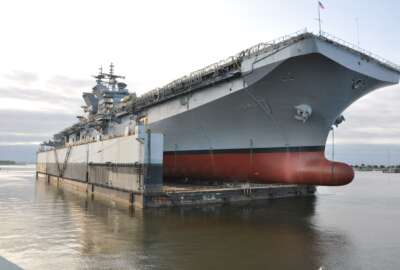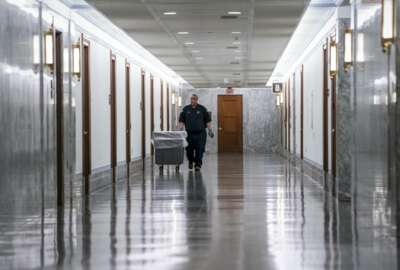
NAVSEA keeps work on ships, fleet moving amid social distancing
Mike Sydla, the division director for Information Management Resources Logistics, Maintenance and Industrial Operations at Naval Sea Systems Command headquarters,...
The Navy operates with a fair amount of open space, namely the world’s oceans. But even the service wasn’t immune from challenges around workforce social distancing due to the coronavirus pandemic. The problem was particularly timely for the Navy’s IT workforce.
Mike Sydla, the division director for Information Management Resources Logistics, Maintenance and Industrial Operations at Naval Sea Systems Command headquarters, said keeping everything moving has meant embracing a new mindset but also keeping some workers in shipyards to continue fleet work.
“So right now at the Naval shipyards we have about 45,000 employees daily working on carriers and submarines, getting them up and ready to go for the nation,” Sydla said on Federal Monthly Insights ꟷ Operational Resiliency.
He called it a “finely orchestrated dance.” When a carrier comes into dry dock and Sydla’s team begins working on it ꟷ that means about 10,000 employees are coming in and out at any given time. He must make sure they’re at the right place with the right tools and doing certified work so that the ship can get out and rejoin the fleet as soon as possible.
“So it is technically impossible not to do this with the IT tools ꟷ the scheduling tools, the planning tools, material tools ꟷ that we bring to the table. And so our goal as part of this organization is not only just to keep what we’re doing but to increase the productivity” he said on Federal Drive with Tom Temin. “If we can increase it by 20 to 30%, that’s a big savings but also more importantly, it gets those aircraft carriers or submarines back to the Navy, to be deployed.”
NAVSEA is one of five systems commands in the Navy and is responsible for planning of buying ships, purchasing ships, maintaining and eventually disposing of them. Sydla said about $30 billion is flowing through the process at any given time, while the $9.7 billion industrial operations in particular focuses on sustaining assets such as submarines, carriers and surface fleet.
But little of this is easily conducive to telework. NAVSEA let employees in overhead positions telework for the first time due to COVID-19, and staff made greater use of online collaboration tools. Waterfront workforces have remained on site every day, but Sydla said they’ve done well to isolate themselves and practice social distancing while getting ships out.
“A lot of things that we’ve said we’d never do, we realized we could do, and we’re now embracing that new change and technology ꟷ particularly the remote operations,” he said. “It was something that I didn’t think the mindset would ever change because a lot of folks are like, ‘I can’t guarantee people are working unless I see them.’”
Now more ideas for distance support are emerging. The IT team used managed services to get people from the operations center working remotely, aside from a few people to come into the office and reboot servers or perform other tasks. Sydla said they looked at the procurement tools they had purchased and finally said, “okay, it’s time to move forward.”
Copyright © 2024 Federal News Network. All rights reserved. This website is not intended for users located within the European Economic Area.
Amelia Brust is a digital editor at Federal News Network.
Follow @abrustWFED





